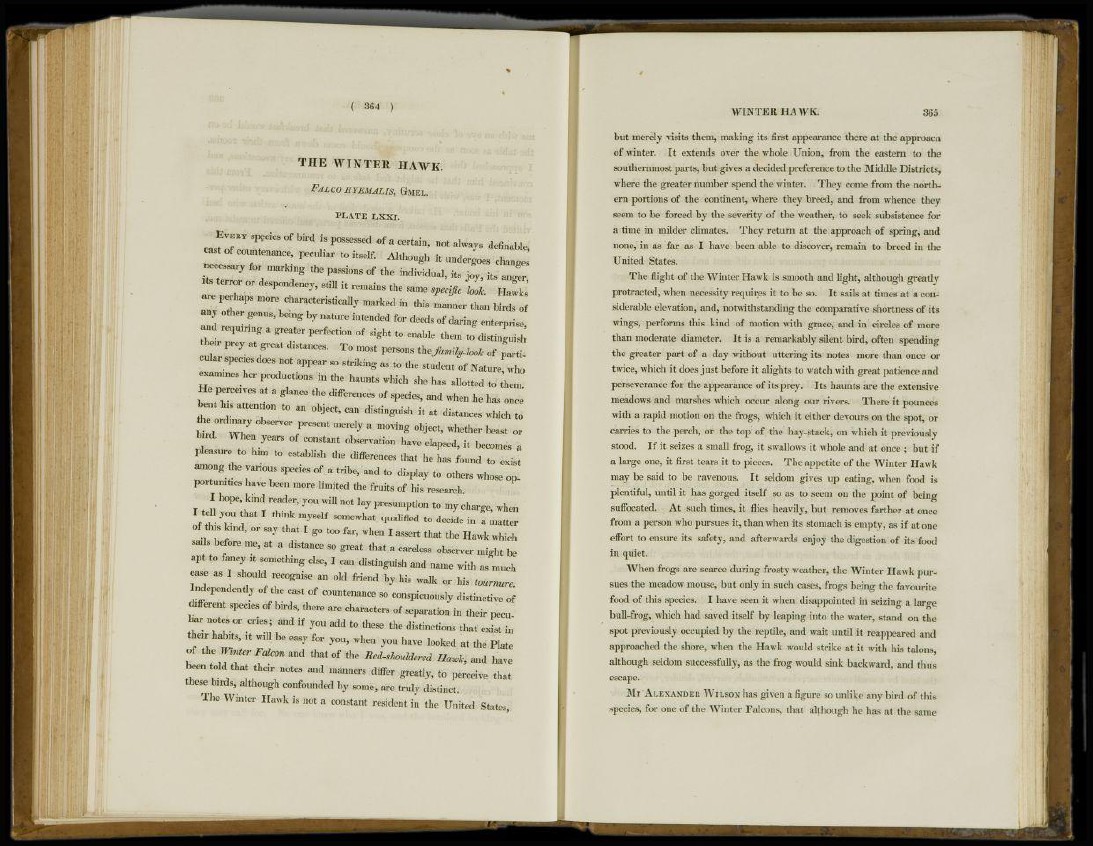
T H E W I N T E R HAWK.
FALCO IIYEMALIS, GMEL.
P L A T E L X X I.
EVERY species of bird is possessed of a certain, not always definable,
cast of countenance, peculiar to itself. Although it undergoes changes
necessary for marking the passions of the individual, its joy, its anger,
its terror or despondency, still it remains the same specific look. Hawks
are perhaps more characteristically marked in this manner than birds of
any other genus, being by nature intended for deeds of daring enterprise,
and requiring a greater perfection of sight to enable them to distinguish
their prey at great distances. To most persons the family-look of particular
species does not appear so striking as to the student of Nature, who
examines her productions in the haunts which she has allotted to them.
He perceives at a glance the differences of species, and when he has once
bent his attention to an object, can distinguish it at distances which to
the ordinary observer present merely a moving object, whether beast or
bird. When years of constant observation have elapsed, it becomes a
pleasure to him to establish the differences that he has found to exist
among the various species of a tribe, and to display to others whose opportunities
have been more limited the fruits of Ins research.
I hope, kind reader, you will not lay presumption to my charge, when
I tell you that I think myself somewhat qualified to decide in a matter
of this kind, or say that I go too far, when I assert that the Hawk which
sails before me, at a distance so great that a careless observer might be
apt to fancy it something else, I can distinguish and name with as much
ease as I should recognise an old friend by his walk or his tournure.
Independently of the cast of countenance so conspicuously distinctive of
different species of birds, there are characters of separation in their peculiar
notes or cries; and if you add to these the distinctions that exist in
their habits, it will be easy for you, when you have looked at the Plate
of the Winter Falcon and that of the Red-shouldered Hawk, and have
been told that their notes and manners differ greatly, to perceive that
these birds, although confounded by some, are truly distinct.
The Winter Hawk is not a constant resident in the United States,
but merely visits them, making its first appearance there at the approacn
of winter. It extends over the whole Union, from the eastern to the
southernmost parts, but gives a decided preference to the Middle Districts,
where the greater number spend the winter. They come from the northern
portions of the continent, where they breed, and from whence they
seem to be forced by the severity of the weather, to seek subsistence for
a time in milder climates. They return at the approach of spring, and
none, in as far as I have been able to discover, remain to breed in the
United States.
The flight of the Winter Hawk is smooth and light, although greatly
protracted, when necessity requires it to be so. It sails at times at a considerable
elevation, and, notwithstanding the comparative shortness of its
wings, performs this kind of motion with grace, and in circles of more
than moderate diameter. It is a remarkably silent bird, often spending
the greater part of a day without uttering its notes more than once or
twice, which it does just before it alights to watch with great patience and
perseverance for the appearance of its prey. Its haunts are the extensive
meadows and marshes which occur along our rivers. There it pounces
with a rapid motion on the frogs, which it either devours on the spot, or
carries to the perch, or the top of the hay-stack, on which it previously
stood. If it seizes a small frog, it swallows it whole and at once ; but if
a large one, it first tears it to pieces. The appetite of the Winter Hawk
may be said to be ravenous. It seldom gives up eating, when food is
plentiful, until it has gorged itself so as to seem on the point of being
suffocated. At such times, it flies heavily, but removes farther at once
from a person who pursues it, than when its stomach is empty, as if at one
effort to ensure its safety, and afterwards enjoy the digestion of its food
in quiet.
When frogs are scarce during frosty weather, the Winter Hawk pursues
the meadow mouse, but only in such cases, frogs being the favourite
food of this species. I have seen it when disappointed in seizing a large,
bull-frog, which had saved itself by leaping into the water, stand on the
spot previously occupied by the reptile, and wait until it reappeared and
approached the shore, when the Hawk would strike at it with his talons,
although seldom successfully, as the frog would sink backward, and thus
escape.
Mr ALEXANDER WILSON has given a figure so unlike any bird of this
species, for one of the Winter Falcons, that although he has at the same